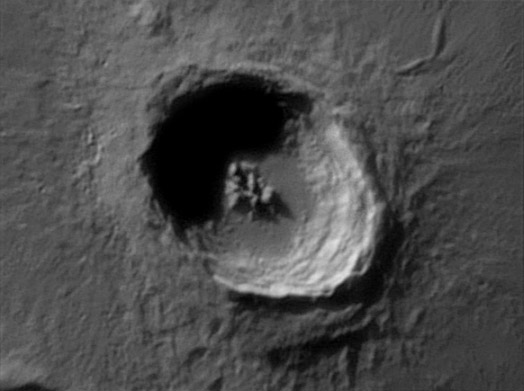
image by François Emond, Hautes-Alpes, FRANCE.
Three days ago LPOD featured the best Earth-based image ever made of Aristillus. Now, another Aristillus image gives a different impression of what the crater is like. Today’s image by François was taken with lower Sun angle than Wes’ masterpiece, and that difference, and a different processing style, adds to our understanding of this young, 55 km wide crater. What caught my eye is the Stonehenge-like slabs that make up the central peaks. The peaks look like they stick nearly straight up in a tight circle, with one fallen slab across the middle. The other feature that shows up very well is the edge of the glacies - the outer, wreath-like wall. The bottom right part of the glacies is straight and casts as shadow, showing that it is relatively steep there. On the left side of the crater there is a very abrupt change of slope, marking the edge of the uplifted country rocks that contribute to the rim height. I also like the narrow shadow cast by the top segment of the rim, showing another change of slope. If you were hiking to the summit, this would be one final steep spot before the success of reaching the top. Our understanding of the Moon is never complete with just one image.
Technical Details:
5 August 2007 at ~ 03 h 41 UT, in Chorges (Hautes-Alpes, FRANCE). Dobson T400 (~ 16″ Newton) + FFC Barlow lens, + webcam Vesta Pro (B & W, raw mode) + red filter with the freeware Iris. 72 frames were stacked in Iris.
Related Links:
Rükl plate 12
François’ website.
Yesterday's LPOD: Brightness Amid the Gray
Tomorrow's LPOD: The Flood Begins
COMMENTS?
Register, Log in, and join in the comments.



